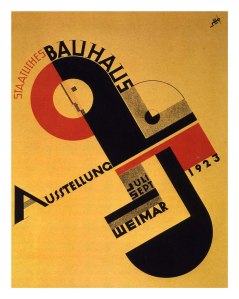Joost Schmidt was a teacher or master at the Bauhaus and later a professor at the College of Visual Arts, Berlin. He was a visionary typographer and graphic designer who is best known for designing the famous poster for the 1923 Bauhaus Exhibition in Weimar, Germany.
 Bauhaus Exhibition Poster 1923
Bauhaus Exhibition Poster 1923
Joost Schmidt began his studies in 1910 at the Großherzoglich-Sächsische Hochschule für bildende Kunst (Grand Ducal Saxonian school of arts) in Weimar and subsequently became a master student of Max Thedy. In the winter semester of 1913/14, he received his diploma in painting. After military service and a period as a prisoner of war, he returned to Germany in 1918. He then took up another course of studies at the Staatliches Bauhaus Weimar. From 1919 to 1924/25, he trained in the workshop for stone and wood sculpture under Johannes Itten and Oskar Schlemmer. In 1921/22, his projects included the design and completion of carvings for the Sommerfeld House in Berlin and the design of a poster for the Bauhaus exhibition of 1923 in Weimar. He also developed a pantomime for this event, which was performed at the municipal theatre in Jena. His involvement in theatre was to lead in 1925 to his design for a mechanical stage. In 1925, having signed an option with Otto Bartning, the director of the Staatliche Bauhochschule Weimar (state school of architecture Weimar) who had planned to employ him as head of the sculpture workshop and head of the sculpture workshop and typographic department, Schmidt instead accepted an offer from Walter Gropius to become a junior master at the Bauhaus Dessau after passing the journeyman’s examination of the Chamber of Crafts Weimar. That same year, Schmidt married the Bauhaus student Helene Nonné. At the Bauhaus Dessau, Joost taught calligraphy for thepreliminary course (1925 to 1932) and directed the sculpture workshop (1928–1930), and the advertising, typography and printing workshop and the affiliated photography department (1928–1932). From 1929 to 1930, he was also a life-drawing teacher, teaching life and figure drawing for the upper semesters from 1930. In addition, Joost Schmidt was responsible for the technical setup of the studio stage. Schmidt did not work at the Bauhaus Berlin. In 1934, in collaboration with Walter Gropius, Schmidt designed the “non-iron metals” section of the propaganda exhibition Deutsches Volk – Deutsche Arbeit (German people – German work). He opened a studio in Berlin in the same year and also worked as a draughtsman/illustrator of maps. In 1935, he accepted a teaching position at the private art school Kunst und Werk (formerly the Reimann-Schule), directed by Hugo Häring. However, he was soon prevented from practicing his profession due to his past affiliation with the Bauhaus. He subsequently worked as a typographer for the publishers Alfred Metzner Verlag and others. After the war, Max Taut appointed him as a professor at the Hochschule für bildende Künste (school of art) in Berlin where he took over the preliminary course for architects. In 1946, he collaborated with other members of the Bauhaus on the design of the exhibition Berlin plant/Erster Bericht, the first exhibition on the city’s plans for reconstruction, held in the Berlin City Palace. In 1947/48, he received an offer from the USA Exhibition Center to design exhibitions. Prior to his death in 1948, he was working on another Bauhaus exhibition and the publication of a Bauhaus book.